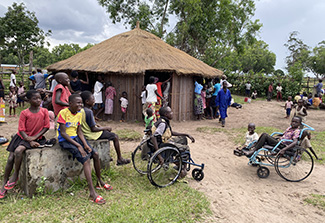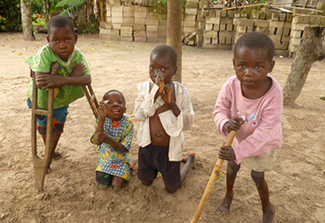The children of Kahemba and the researchers hoping to save them
November / December 2022 | Volume 21 Number 6
 Photo courtesy of Neerja VashistKahemba residents gather near the health center. Though Dr. Desire Tshala searched for answers in the lab, the villagers remained foremost in his thoughts.
Photo courtesy of Neerja VashistKahemba residents gather near the health center. Though Dr. Desire Tshala searched for answers in the lab, the villagers remained foremost in his thoughts.
By Susan Scutti
All researchers of konzo, a paralyzing disease that can occur in impoverished regions where bitter cassava is a food staple, share at least one thing in common: utter shock when first encountering the disease. Dr. Desire Tshala, who grew up in a modern, urban area of the Democratic Republic of Congo (DRC), said, “I couldn't believe that in my own country, just 600 miles from the capital city, Kinshasa, people were living in such a high degree of poverty and malnutrition. In the villages in and near Kahemba, DRC, about two out of 10 people" are affected.
The Yaka tribe's word “konzo," referring to an antelope tethered at its knees, was used to describe cases seen in the Belgian Congo in 1928. Later, this term was adopted by Dr. Hans Rosling, the late Swedish physician and epidemiologist, who began characterizing the disease in 1989. At that time, no one understood what caused konzo: Was it a virus? Mutations? Rosling identified the cassava plant, a tuberous root containing toxic cyanide that also happens to be the world's fourth most consumed food staple.
Specifically, Rosling showed that cyanide poisoning from cassava, when it coincides with a diet lacking in sulfur-based amino acids, can damage upper motor neuron pathways within an individual's brain. The result is sudden, non-progressive and non-reversible paralysis of the lower and/or upper extremities in severely affected people. So a child—usually those affected are malnourished children or mothers of child-bearing age—who has been eating cassava lifelong will wake up one morning either limping or needing a stick to walk or only able to crawl. This condition will remain unchanged throughout the child’s life. (In rare cases, another meal of improperly processed, toxic cassava will worsen the paralysis.)
Because konzo happens in isolated, rural areas, the exact number of cases remains unknown, though scientists estimate hundreds of thousands of affected people, most of them living in the DRC. The disease usually occurs as an outbreak triggered by crisis situations, such as drought, civil wars or famine.
Dr. Julie Cliff, a physician and epidemiologist who worked with Rosling in Mozambique, explained, “Everybody says, 'Once you've seen konzo, you have to do something, you cannot stop.' It's just a horrifying sight to see so many people paralyzed. And in rural areas, paralyzed people cannot walk to their fields, yet they still crawl. I find that particularly moving."
Dr. Matthew Bramble, a genetic medicine researcher who is
exploring connections between konzo and the gut microbiome, said, “You can read all you like about cassava-associated paralysis, but when you go to the village and the kids are greeting you on all fours and people have canes and, later, the person you're eating with is on the ground, well…. The community is completely used to it, and that is the most unusual component of konzo."
Dr. Michael Boivin, a neuropsychology specialist whose research in the Democratic Republic of Congo began in the 1980s, credits one man as the driving force behind much of the konzo research happening today: “Desire Tshala. He's at the center of it all."
Spearheading prevention
Dr. Desire Tshala was 31 when he first confronted konzo. Dr. Thorkild Tylleskar, a former Rosling student, suggested Tshala work with him in the field. That was 1996. Tshala's neuro-epidemiological characterization of konzo, a project for his Ph.D. thesis, involved transporting villagers in remote, konzo-affected areas to cities and conducting “electrophysiology investigations with equipment brought from Sweden." This early research sparked his passion and resulted in a logical progression towards increasing scientific understanding of konzo's effects.
 Photo courtesy of Michael BoivinA child who has been eating cassava lifelong will wake up one morning either limping or needing a stick to walk or only able to crawl. This condition will remain unchanged throughout the child’s life.
Photo courtesy of Michael BoivinA child who has been eating cassava lifelong will wake up one morning either limping or needing a stick to walk or only able to crawl. This condition will remain unchanged throughout the child’s life.
“If we want a cure someday, then we need to understand the mechanism of cassava toxicity," reasoned Tshala. In the lab of Dr. Peter Spencer at Oregon Health & Science University he gained postdoc experience in neurotoxicology. Next, he trained in molecular biology. Eventually, his projects received funding from Fogarty, the National Institute of Environmental Health Sciences (NIEHS), and the National Institute of Neurological Disorders and Stroke (NINDS), enabling him to develop an experimental lab model and explore his most pressing questions. “In the same village or family, you'd see that some children are more susceptible than others, so I was looking for a biomarker." By 2016, his experiments on rodents had suggested that cyanate, a chemical relative of cassava cyanide, may be associated with konzo. Using this knowledge, his team more fully investigated the risk factors of chronic malnutrition and cassava toxicity, all of which affect a child's growth, he said. "But we still had questions. So, next, we introduced a genetic component to our research."
The value of konzo research extends far beyond African villages, he explained. “Our models and what we are learning from the various studies—including epigenetic, microbiome, and toxicology studies—is very helpful in terms of understanding all motor neuron diseases, including ALS." His research is also relevant in terms of studying the toxicity itself. “We work on cyanide, an important toxin in chemical warfare, and our understanding of it benefits the counterterrorism program at NINDS."
The wetting method
Though his research grew more sophisticated, the villagers of Kahemba remained foremost in Tshala's thoughts. (Kahemba, a konzo-affected area in the DRC where Tshala conducts much of his research, means “place of suffering" in the local language.) Seeing the prevalence of paralysis, he decided his team could no longer continue observational studies. “We needed to start an intervention to prevent the disease." He collaborated with Dr. James Howard Bradbury's team to introduce the wetting method in Kahemba (with added help from the DRC's National Nutrition Program at the Ministry of Health).
The wetting method removes the toxic components of cassava, mainly linamarin and acetone cyanohydrin, from cassava flour, according to a
study co-authored by Bradbury and Cliff. A food preparer mixes cassava flour with water and creates a thin layer of mixture which is left to dry for two hours in the sun or five in the shade. During this time, the chemicals break down, producing hydrogen cyanide gas, which harmlessly dissipates into the atmosphere.
Dr. Julie Cliff helped field-test the wetting method in Mozambique. “It should work to prevent konzo, it doesn't take too long, and the rural women find it easy to use."
Tshala's team recently conducted a clinical trial comparing training by nutritionists versus training by village women (peer-training). “We just finished data collection and cleaning and soon we'll see the outcome." If the peer-trainers performed as well as—or better than—the nutritionists, Tshala believes the Ministry of Health could invest in programs where village women teach and perpetuate the wetting method amongst themselves.
Though hopeful, Tshala knows he faces an uphill battle. “While the wetting method works, it's difficult for people to change the way they've been processing food." Also, Tshala expects that natural catastrophes, like droughts or flooding, and climate variations, will likely increase the prevalence of konzo in the African countries already affected: DRC, Angola, Zambia, Tanzania, Mozambique, Uganda, Cameroon, and Nigeria. “I feel that in the next years, we will have more toxicity."
In truth, the best way to prevent konzo is to eliminate poverty, he said. “I've been working in konzo-affected areas for 25 years now and it's clear that we need a systemic solution to fight poverty. If you get a road running through rural areas to connect different communities, it would improve trade, circulate goods, and people would be able to diversify their diet. They'd avoid malnutrition. They'd be less susceptible to the toxicity of cassava."
The poorest of the poor
Cliff's own global health career stretches back to the 1970s. After a stint in Tanzania, the Australian native began working in Mozambique, where, in 1981, she faced her first konzo epidemic as a Ministry of Health physician. “We had a huge epidemic—hundreds of cases of paralyzed children, women of reproductive age, and a few men. It was overwhelming." Rosling, who had been working in the district, and Anders Molin, a Swedish doctor, investigated. This led to subsequent publications and a landmark epidemiological case history.
In the years following, Cliff continued to research konzo and the wetting method, while making significant contributions to the development of the Mozambique health system. She also contributed to a data report on konzo sponsored by the WHO. While the UN health agency has shown some interest, it hasn't been enough, she explained. "We, the konzo workers, have felt continually frustrated because we've never managed to get this issue onto the agenda of the big organizations."
This is because konzo is a problem among the poorest of the poor, she said. “The solution is development. Put resources into these poor, rural areas. Give them agricultural support."
More Information
Updated December 15, 2022
To view Adobe PDF files,
download current, free accessible plug-ins from Adobe's website.
Related Fogarty Programs
Related World Regions / Countries
Related Global Health Research Topics